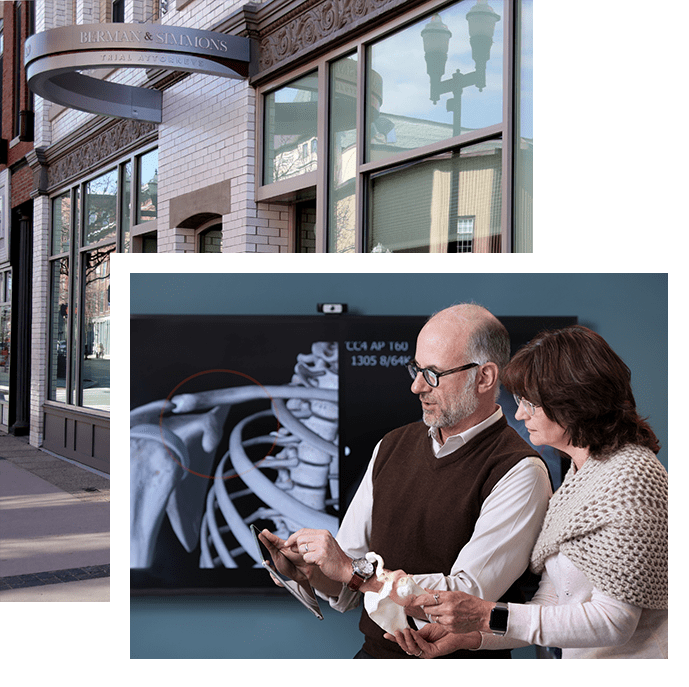Spinal Cord Injury Attorneys
Berman & Simmons recently represented a driver from midcoast Maine who was injured when she was rear-ended by a telephone company truck. The woman suffered a whiplash injury with trauma to her neck, back, and spinal cord. She endured multiple surgeries, physical therapy, and a long, painful recovery process. She also lost thousands of dollars in wages because of the time she was forced to miss work.
When the insurance company for the other driver refused to fairly compensate her, we took the case to trial and won a $750,000 verdict for the woman.
Unfortunately, many accident victims who suffer spinal cord, neck and back injuries never receive the money they deserve for medical care, rehabilitation, and lost wages.
Spinal cord injuries (SCI) are among the most serious and devastating injuries a person can suffer. An estimated 275,000 Americans are living with a spinal cord injury, and each year, another 12,500 are injured. These injuries require expensive medical care and ongoing treatment and services, sometimes for the rest of a person’s life.
Learn more about spinal cord injuries
SCI is typically caused by a traumatic blow to the spine that fractures or dislocates vertebrae. This is commonly referred to as a broken neck or broken back. The trauma causes bones, bone fragments, discs, or other structures to damage the spinal cord tissue. If the spinal cord is torn or severed, the victim can suffer paralysis.
The level of injury is the lowest point on the spinal cord below which sensory feeling and motor movement are impacted.
Cervical Spinal Cord Injury C1 – C8
Cervical Spinal Cord Injury C1 – C8. Cervical level injuries cause paralysis or weakness in both arms and legs (quadriplegia). All regions of the body below the level of injury or top of the back may be affected. Sometimes this type of injury is accompanied by respiratory issues, bowel, bladder, and sexual dysfunction, and loss of physical sensation. This area of the spinal cord controls signals to the back of the head, neck and shoulders, arms and hands, and diaphragm. Since the neck region is so flexible it is difficult to stabilize cervical spinal cord injuries. Patients with cervical level injuries may be placed in a brace or stabilizing device.
Thoracic Spinal Cord Injury T1 – T12.
Thoracic level injuries in the mid-spine area are less common because of the protection given by the rib cage. Thoracic injuries can cause paralysis or weakness of the legs (paraplegia) along with bowel, bladder, and sexual dysfunction, and loss of physical sensation. In most cases, arms and hands are not affected. This area of the spinal cord controls signals to some of the muscles of the back and part of the abdomen. With these types of injuries most patients initially wear a brace on the trunk to provide extra stability.
Lumbar Spinal Cord Injury L1 – L5.
Lumbar level injuries in the lower spine area result in paralysis or weakness of the legs (paraplegia). Bowel, bladder, and sexual dysfunction can occur, as well as loss of physical sensation. The shoulders, arms, and hand function are usually unaffected. This area of the spinal cord controls signals to the lower parts of the abdomen and the back, the buttocks, some parts of the external genital organs, and parts of the leg. These injuries often require surgery and external stabilization.
Sacral Spinal Cord Injury S1 – S5.
Sacral level injuries at the bottom of the spine primarily cause loss of bowel and bladder function, as well as sexual dysfunction. These types of injuries can cause weakness or paralysis of the hips and legs. This area of the spinal cord controls signals to the thighs and lower parts of the legs, the feet, and genital organs.
Types of spinal cord injury
The two major types of spinal cord injury are tetraplegia and paraplegia.
Tetraplegia
Tetraplegia (formerly called quadriplegia) affects both arms and both legs. It is caused by trauma anywhere between the C1 and the T1 vertebrae. People with tetraplegia can experience a loss of sensation, function, or movement in their head, neck, shoulders, arms, hands, upper chest, pelvic organs, and legs.
Paraplegia
Paraplegia affects the lower body. People with paraplegia have partial or complete lost feeling and motor function in the lower parts of their body, such as stomach, hips, legs and feet. It is caused by trauma anywhere between the T2 and the S5 vertebrae.
Degree of severity of spinal cord injury
The severity of spinal cord injuries is described as either complete or incomplete.
Complete Injury
A complete injury means there is no voluntary movement or sensation below the level of the injury.
Incomplete Injury
An incomplete injury means there is some functioning below the level of the injury.
Strong advocates for victims of spinal cord injuries in Maine and New England
Spinal cord injuries are often caused by someone else’s negligent or reckless action, such as a car accident, an act of violence, a workplace fall or by some other means. In those cases, Maine law entitles the injured person and their families to recover financial damages. Berman & Simmons is widely recognized as the best personal injury lawyers in Maine and among the best in the U.S. It’s our mission to hold the responsible party accountable and to make sure you receive full compensation for your losses.

A Law Firm That Listens
Berman & Simmons is widely recognized as the best personal injury lawyers in Maine and among the best in the U.S., having won many of the largest jury verdicts and settlements ever obtained for injured people in Maine.
Our trial lawyers have won thousands of claims on behalf of those injured in a car accident, and each year we build on that successful track record.
Our attorneys and staff members will take the time to listen to you, work to understand your concerns, and come up with solutions that can make your life better, including obtaining payment for or deferral of your debts until your case is resolved. We help you recover and make sure you receive full compensation for your injuries and loss.
Don't wait to hire a personal injury lawyer:
Maine has strict deadlines for filing many personal injury claims.
The other insurance company is likely already building their client’s case against you.
Witnesses may become unavailable and evidence may be lost or degraded with time.
You’ll need help navigating your medical care and dealing with financial pressures.
You need peace of mind to focus on your recovery.
$8.5 Million
Paralysis due to mismanagement of
degenerative spine
$2.5 Million
Catastrophic injuries in a head-on car accident
$800,000
Wrongful death case involving negligent
motorist
$715,000
Plaintiff Rear Ended by
Telephone Truck
$5 Million
Delay in diagnosis and treatment of cancer
$1.2 Million
Significant Head Injury Car Accident
Spinal Cord Injury FAQs
-
What should I do if I have suffered a spinal cord injury?
The prognosis is different for everyone who experiences a spinal cord injury. Some patients recover fully and within a period of months; others suffer injuries that are likely to be permanent. Individual outcomes are influenced greatly by the timing and quality of medical care, and the support systems (family, community, medical) available to each person.
- Immediate, high quality medical care is essential after a spinal cord injury. Victims should avoid any movement while first responders and doctors oversee your care.
- After your immediate symptoms have been addressed and you are in a stable condition, doctors will work with you and your family to create a detailed plan for your recovery. This may include additional surgeries, medications, physical therapy, and other components.
- Emotional and mental health supports are also essential following a spinal cord injury. Individuals should consider a range of therapies to maintain a positive outlook, as depression and anxiety are common for SCI survivors.
-
What types of compensation are available to spinal cord injury victims?
There are two types of damages for which you could receive compensation: Economic and non-economic.
Economic damages include damages that can be calculated or fairly estimated, such as past and future medical expenses, lost wages and lost earnings potential. Expert witnesses can testify about how the injury impacted the person’s ability to earn a living in the future. These type of damages are sometimes referred to as “out of pocket” expenses.
Non-economic damages compensate victims for losses that are much harder to assign a specific dollar amount. Pain and suffering, loss of enjoyment of life, the loss of companionship from a loved one, or permanent loss of function or permanent disfigurement are all types of non-economic damages.
-
What is the most common cause of spinal cord injury?
According to the World Health Organization (WHO), car accidents are the most common cause of spinal cord injury (SCI). Specifically, car rollovers account for 70 percent of road accidents causing SCI. Other common causes include falls and violence.
The most common spinal cord injuries affect the vertical and thoracic areas. These injuries can cause permanent and lifelong disability.
-
What is a spinal cord injury?
Spinal cord injury involves any damage to the spinal cord or nerves attached to the spinal canal. Every year, between 240,000 and 500,000 people suffer a SCI.
The consequences of a spinal cord injury can be devastating, including semi or permanent loss of strength, sensation, and function below the injury site. This can obviously have a tremendous impact on the victim’s ability to work, socialize, travel, and manage day-to-day functions without assistance.
Spinal cord injury survivors’ lifetime care can be costly. Many are on permanent disability, require home healthcare, or reside in assisted living facilities. A personal injury lawsuit is designed to compensate the victim for these economic damages and provide for the pain, suffering, emotional trauma, and lost quality of life caused by the accident.
-
How much should you expect from a back injury settlement?
Back injury settlements can vary, ranging in value from modest to significant. However, traumatic spinal cord injuries typically settle for an average of $1 million. The difference is that a “back injury” involves damage to the bones around the spinal cord (vertebrae). While painful, this condition typically does not cause a spinal cord injury’s permanent, lifelong effects, which can permanently compromise mobility.
The amount of compensation for either a back injury or spinal cord injury will depend on several factors, including:
- The impact of the injury on your life and livelihood.
- The amount of medical bills;
- The length of treatment required to repair it;
- The invasiveness of treatment, including whether the injury required surgery;
- How the injury impacts your life expectancy;
- Whether you were at fault for the accident.
Maine is a modified comparative negligence state, which means that you must be less than 50 percent at fault for the accident to recover damages. Provided you meet that standard, any percentage of fault attributed to you will reduce your total recovery.
For example, you may have been hit in the rear after you stopped short. If your injury is worth $100,000, but the jury finds you to be 20 percent at fault, you will recover $80,000.
